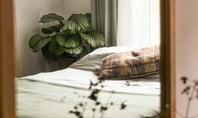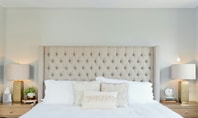Relaxing colours for a cosy home
Are you often agitated, find it hard to unwind or have trouble falling asleep? This could be due to a variety of things – such as how you plan your day, your sleep pattern, stress at work and many more. What you may not have considered is that the interior design and, in particular, choice of colours in your home can also have an effect on your mind. We’d like to take you on a little journey to discover the effects of colour and introduce you to five relaxing wall colours.
by CALIDA
October 21, 2024•5 min reading time

A calm sunrise with gentle colour transitions of pink and blue, harmoniously blending sky and sea.
Table of Contents
Five relaxing wall colours and their effects
• Soft earthy tones for a natural atmosphere
• Green walls create cosy forest vibes
• Blue gives you peace of mind
• Grey is reminiscent of the silence of the night
• Warm yellow and orange tones have an anxiety-relieving effect
What you need to keep in mind when choosing relaxing wall colours
• Tip 1: your taste has priority
Five relaxing wall colours and their effects
Colours actually have a very strong effect on our brain and thus also on our mood. Just like smells or sounds, they can evoke positive and negative associations that can agitate, calm or invigorate us.
If you want to turn your home into a space that radiates peace, it’s a good idea to take a look at the effects of different wall colours. White walls may be the standard in many homes, but they don’t necessarily create a relaxing atmosphere. Here are five colours/colour schemes that will transform your home into a cosy retreat.
Soft earthy tones for a natural atmosphere
If you really want to ground yourself and unwind, it’s best to integrate natural colours into your home. Shades of brown, sand, beige and off-white are not only modern, but also have a calming effect on our mood. They softly reflect the colours of nature and are an ideal alternative to cool white walls.
Green walls create cosy forest vibes
Just like earthy tones, the colour green will transform your room into a natural retreat reminiscent of a peaceful walk in the woods. Whether it’s a rich moss green, dark fir green or light pastel tones, you can find the entire spectrum of greens outside in nature. To create a special rustic, natural feeling, green tones can be combined wonderfully with wooden furniture, but also with modern furnishings – making it a true all-rounder.
Blue gives you peace of mind
Even though the first thing that springs to mind for many people when they think of the colour blue is a baby-blue children’s room or that it’s a cool tone, the right shades of blue can actually create a cosy atmosphere in living spaces and bedrooms.
Muted colours such as dove blue or light shades of blue in particular, but also bold sky blue and azure, have a relaxing and mood-boosting effect at the same time. These hues are reminiscent of the vastness of the sky and the sea, and can make you feel like you’re on holiday. A dark midnight blue, on the other hand, has a mystical and profound effect, much like the next colour we’d like to talk about.
Grey is reminiscent of the silence of the night
For many, the colour grey may not initially come into question as a wall colour. However, grey can actually be used in many different ways in the living room and bedroom. Depending on the undertone and combination, this colour doesn’t necessarily look cool or like it belongs in an office.
Grey tones that go into the violet or dove spectrum actually appear warm and make it feel as though it’s twilight, also known as the ‘blue hour’. If you are unable to sufficiently block out light in your bedroom and want to create an environment that promotes sleep, this colour is a great choice.
Warm yellow and orange tones have an anxiety-relieving effect
Yellow, orange, red, ochre and mustard: for many people, these warm colours are more invigorating than relaxing at first. But those who suffer from anxiety disorders or struggle with negative thoughts can use these colours to calm themselves down and encourage positive thinking.
These warm tones are reminiscent of sunshine, campfires and candlelight, and are especially suitable for Mediterranean-style living rooms. If you don’t want to paint an entire wall in yellow, red or orange, you can create a similar atmosphere with indirect light sources.
What you need to keep in mind when choosing relaxing wall colours
Painting your walls is already a step in the right direction towards creating a calm atmosphere. Here are three additional tips on what else you should consider to make your home cosier and more relaxing.
Tip 1: your taste has priority
In this blog post, we have revealed five colours/colour schemes and their effects. But even if you love the vastness of the sea, that doesn’t necessarily mean that a blue wall will solve your problems – especially if you’re not actually a fan of blue. You should also bear in mind that colours can look very different depending on the amount of light and the time of day.
Before you get too keen to give your walls a new coat of paint, it’s best to first apply a few samples to the wall in question and spend a few days or even weeks comparing the colours. This will give you a good idea of the effect the wall colours have and whether you even like them. After all, a relaxing colour is anything but relaxing if it doesn’t suit your taste.
Tip 2: choose the right decor
It’s not only the colour of the walls that matters when creating a relaxing atmosphere, but everything else in the room as well. Before you paint your walls, think about which decorative elements, furniture, etc. you want to keep and what you can replace. The colour of your walls should ideally match your decor to create a harmonious overall look.
Less is more when it comes to decor in a relaxing atmosphere. Avoid chaos caused by too much clutter and focus on a few decorative elements that are a similar colour to your walls or one that works in harmony with them. Crazy colour combinations and colour blocking should be used sparingly if a relaxing effect is what you’re hoping to achieve. But of course, your taste is also the top priority here.
Tip 3: add extra relaxing elements
As already mentioned at the beginning: in addition to colours, other components also play an important role in you feeling comfortable and completely relaxed in your home. Room fragrances are a great way to unwind: lavender, woody smells and citrus fragrances such as orange and bergamot have a strong effect on our well-being and really help us to feel calm.
You should also consider the arrangement of your furniture when designing your room. According to Feng Shui, for example, you shouldn’t hang up mirrors in your bedroom or opposite a door. This traditional Chinese practice of creating harmony encourages the inclusion of curved shapes instead of hard edges and lots of plants to ensure peace and strength within your own four walls.
Ultimately, you should simply try out for yourself what feels best for you. Don’t be afraid to move furniture around and try displaying things from a different angle in your home. With the right wall colour, minimalist decor and pleasant fragrances, you should feel much more relaxed.
Discover more interesting blog posts:


